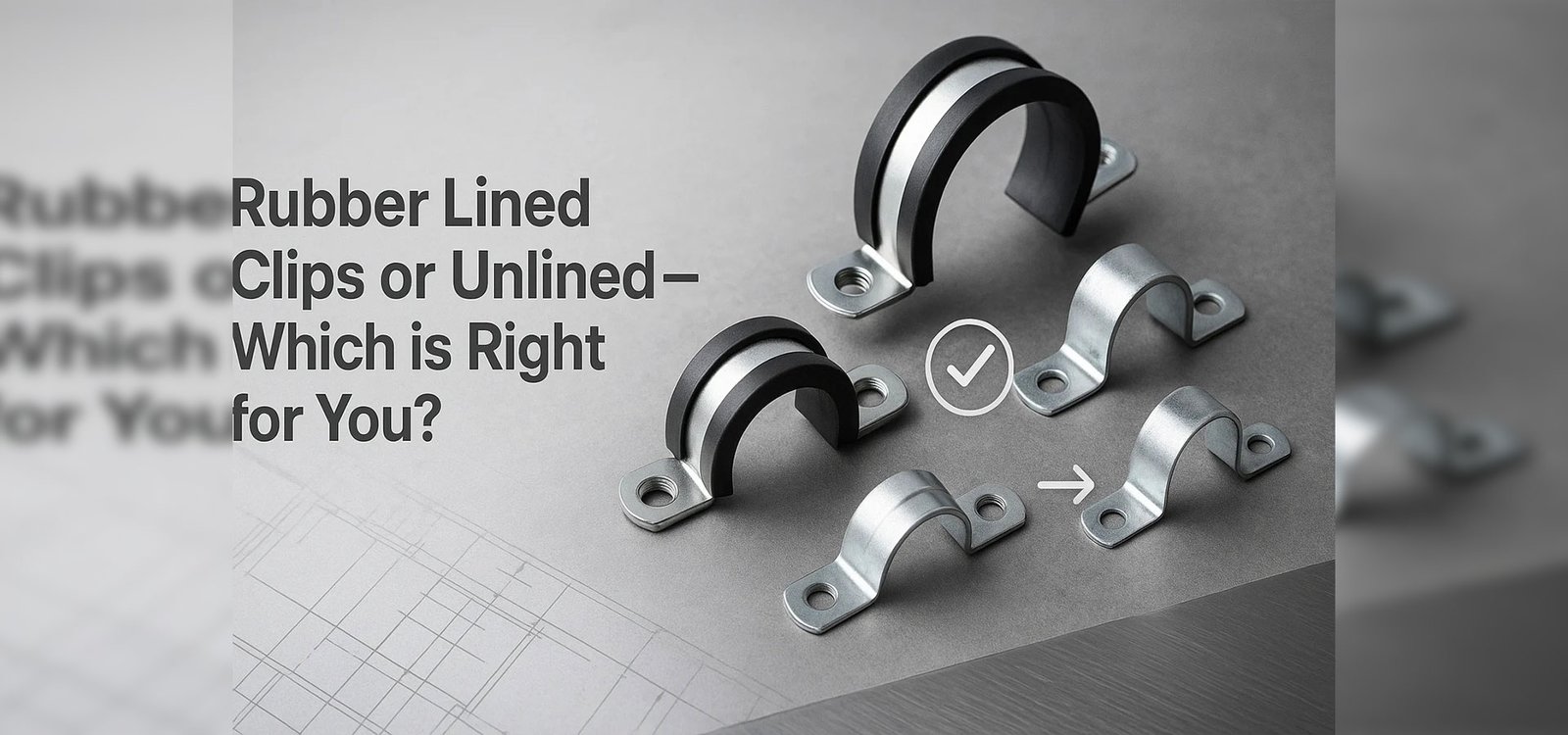Paul here again. Got a question last week from a young lad who’d just started his apprenticeship – “Why do some pipe clips have rubber in them and others don’t?” Good question, actually. Wish someone had explained it to me properly when I was starting out, would’ve saved me a few headaches over the years.
The rubber lining might seem like a small detail, but get it wrong and you’ll know about it. Either from noise complaints, pipe damage, or both. Let me tell you what I’ve learned about when to use rubber lined clips and when you can get away without them.
What Are Rubber Lined Clips?
Basically, they’re standard metal pipe clips – usually steel or malleable iron – with a rubber insert that sits between the clip and the pipe. The rubber acts as a cushion, stopping direct metal-to-metal contact.
You get them in all the usual sizes, from 15mm domestic stuff right up to… well, I’ve seen some massive ones on industrial jobs. The rubber lining is typically EPDM or similar – something that stays flexible over time and doesn’t react with the pipe material. Actually, I’m not entirely sure what EPDM stands for – some chemical thing – but it’s good stuff.
What’s the Difference Between Them?
Right, so the main differences… where do I start? Noise is probably the big one. Direct metal contact between clip and pipe transmits every little vibration and water hammer through the building structure. You know that annoying ticking sound when the heating fires up? That’s usually unlined clips conducting noise from thermal expansion.
Had a job in a converted warehouse – luxury flats with exposed services as a “design feature.” Client loved the industrial look until the first residents moved in and started complaining about noise every time someone turned a tap on. Swapped out all the unlined clips for rubber lined ones, problem solved. Well, mostly solved – still had some issues with the pump, but that’s another story.
Rubber lined clips also protect the pipe surface. Copper’s quite soft, and direct contact with steel clips can mark it or wear through over time, especially if there’s vibration. The rubber acts as a barrier.
Oh, and there’s the galvanic corrosion thing. Different metals in contact can cause problems – like a tiny battery that makes things rust faster. Rubber stops that by preventing direct contact. Though to be honest, I’ve seen plenty of copper pipes with steel clips that have lasted years without major issues. Depends on the environment, I suppose.
Cost-wise, rubber lined clips are more expensive. Maybe 20%, sometimes more if copper prices are up. Which reminds me, I should check copper prices – got a big job coming up and need to price it properly.
When I Use Rubber Lined Clips
Residential heating systems – always. The noise reduction alone is worth it. Had a client in Stockport who was getting complaints from upstairs neighbors about heating noise. Turned out the original installer had used bog-standard unlined clips throughout. Nightmare job to retrofit, but we got there in the end.
Copper pipework – pretty much always, for the galvanic protection and surface protection. Though I’ll admit, I’ve cut corners on hidden runs in plant rooms before. Not proud of it, but sometimes the budget just won’t stretch.
Areas where people live or work – definitely. No point saving a few quid on clips if you’re going to get noise complaints later.
Mixed metal installations – copper pipes with steel clips being the obvious one. Though these days, everything’s mixed metals. Stainless steel this, plastic that. Sometimes I wonder if we’re overthinking it all.
When Unlined Clips Are Fine
Plant rooms and industrial areas where noise isn’t a concern. If it’s all steel pipework going to steel brackets, galvanic corrosion isn’t really an issue. Still get some noise, but in a boiler room, who cares?
External pipe runs can often get away with unlined clips, though I’d still consider rubber lining for thermal movement benefits. Had a job last winter where external heating pipes were expanding and contracting so much they were stressing the joints. Rubber lined clips might have helped, but by then it was too late to change.
Budget projects – sometimes you just have to make compromises. Better to have adequate support with unlined clips than inadequate support spacing because you’ve blown the budget on fancy rubber lined ones.
Sizing and All That
Common sizes… let’s see. 15mm rubber lined clips for smaller feeds, though I mostly use them for radiator connections where noise would be really obvious. 22mm are probably what I use most – flow and return pipes for domestic heating. 50mm for bigger commercial stuff, though I don’t do as much of that these days.
Actually had a funny situation last month – ordered 22mm rubber lined clips for a job, turned up and they wouldn’t fit properly. Turns out the rubber takes up space inside the clip, so you sometimes need to go up a size. Should have known that after all these years, but you live and learn.
Heavy duty ones for really big applications – process piping, large commercial heating. 110mm and above, you’re usually looking at industrial applications. Did a job at a chemical plant once where we needed clips rated for some ridiculous load. Can’t remember exactly what, but they were expensive. Everything’s expensive on chemical plants though.
Steel Pipes and Rubber Lining
Even with steel-to-steel mounting, rubber lined clips can make sense. Had this office building where the boiler was directly below meeting rooms. Steel pipework throughout, so no galvanic issues, but the noise transmission was terrible. Facilities manager was getting complaints every time the heating kicked in.
Installed rubber lined clips for the whole system – made a huge difference. Still wasn’t perfect because the pump was transmitting vibration through the structure, but much better. Cost about £200 extra in clips for a job worth thousands, so hardly broke the bank.
The Anti-Vibration Thing
This is where it gets interesting. Rubber lined clips are basically anti-vibration mounts for pipes. Break the solid connection, stop the vibration transmission. Simple concept, works well in practice.
Had a hotel job where the boiler room was below guest rooms. Nightmare scenario – guests complaining about noise and vibration every time heating came on. We ended up doing the whole lot – anti-vibration mounts under the boiler, rubber lined clips for all pipework, even special pads under the pumps. Probably overkill, but the manager was desperate.
Do anti-vibration mounts work? Absolutely, when done properly. The hotel job proved that – went from constant complaints to zero noise issues overnight. Well, nearly overnight – took us three days to do all the work.
What’s the best rubber for anti-vibration? EPDM’s usually fine for most heating work. Good temperature range – think it’s something like minus 20 to plus… 120? Something like that. Silicone’s better for extreme temperatures but costs more. Most of the time EPDM does the job.
Shore hardness matters too – how firm the rubber is. Too soft and it squashes too much; too hard and it doesn’t absorb vibration. I don’t pretend to understand all the technical details, but the manufacturers usually get it about right for standard applications.
Material Compatibility
Copper pipes with steel clips – rubber lining essential. The galvanic thing is real, though I’ve seen plenty of installations where they’ve ignored it and been fine for years. Still, why take the risk?
Steel pipes – either type works. Rubber lined for noise reduction, unlined if you don’t care about noise and want to save money.
Plastic pipes need rubber lining to protect from crushing. Learned that one the hard way on an early job – crushed a plastic heating pipe by over-tightening an unlined clip. Expensive mistake.
Stainless steel – rubber lining stops marking the surface. Stainless is expensive, so you don’t want to damage it with direct metal contact.
Installation Tips
Don’t over-tighten rubber lined clips. The rubber does the work – you don’t need to crank them down like unlined ones. Made this mistake early in my career and damaged both the rubber and the pipe.
Check the rubber condition before installation. Sometimes clips sit in storage for ages and the rubber goes hard or cracks. No point installing defective clips.
Spacing’s the same as unlined clips – don’t assume rubber lining means you can increase spacing. Follow the standard guidelines for whatever pipe you’re working with.
Replace rubber lined clips eventually. Rubber degrades over time, especially in high-temperature applications. Plan for replacement maybe every 15-20 years? Depends on the environment really.
Cost and Value
Initial cost is higher – maybe 20-30% more than unlined clips. Sounds like a lot, but we’re talking pence per clip on most jobs. On a typical house heating system, the extra cost might be £20-30 total. Not massive in the context of a heating installation.
Long-term, rubber lined clips usually pay for themselves. Less vibration means less wear on pipes and joints. Fewer callbacks for noise complaints. Better customer satisfaction. All that stuff adds up.
Had a client who went for cheap unlined clips against my advice. Within two years, they were getting noise complaints and had to retrofit rubber lined ones. Cost them more in the end than doing it properly first time.
Where to Get Them
Most merchants stock the basic sizes. Heating specialists usually have better selection. Won’t mention specific suppliers, but the usual suspects generally have what you need.
For unusual sizes or specialist applications, you might need to go to pipe support specialists. They know their stuff and can advise on technical requirements.
Common Mistakes
Using standard EPDM in really high-temperature applications. Sometimes you need silicone or other specialist rubbers, but for most heating work EPDM’s fine.
Wrong size selection – forgetting that rubber lining takes up space inside the clip. Always check manufacturer specs.
Over-tightening – the rubber compresses to grip the pipe, you don’t need excessive force.
Leaving rubber lined clips in place for decades until the rubber hardens and fails. Eventually they need replacing, though good quality ones last ages.
Ignoring environment – using indoor-rated clips outdoors, or standard rubber in chemically aggressive environments.
Types of Rubber
EPDM’s the standard – good temperature range, weather resistant, doesn’t react with most things. Think the temperature range is about minus 20 to plus 110, something like that. Don’t quote me on exact figures.
Nitrile for oil resistance – fuel lines, anywhere hydrocarbon contact’s possible. Not as flexible at low temperatures though.
Silicone for extreme temperatures or where you need maximum flexibility. More expensive but sometimes worth it.
Neoprene’s old school – still see it on older installations but EPDM’s generally better these days.
Shore hardness… honestly, I leave that to the manufacturers. They know what works for different applications better than I do.
Final Thoughts
The choice usually comes down to application and budget. For most residential and commercial work, the extra cost of rubber lining is worth it for noise reduction alone.
I default to rubber lined clips for most jobs now. Yes, they cost more, but the benefits usually justify the expense. Only time I regularly specify unlined clips is industrial applications where noise isn’t a concern and you need maximum clamping force.
Remember, pipe clips might seem minor, but they affect how the whole system performs. Get them right from the start and save yourself grief later.
Been rambling a bit here, but that’s the nature of these things. Every job’s different, every client’s different. Use your judgment, ask questions if you’re not sure, and don’t be afraid to spend a bit extra on quality components.
Any specific questions, you know where to find me. Always happy to chat about this stuff over a cup of tea.
Paul

